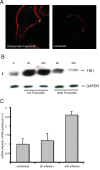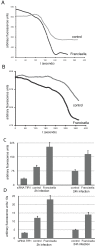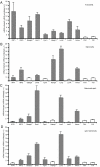Modulation of iron homeostasis in macrophages by bacterial intracellular pathogens
- PMID: 20184753
- PMCID: PMC2838877
- DOI: 10.1186/1471-2180-10-64
Modulation of iron homeostasis in macrophages by bacterial intracellular pathogens
Abstract
Background: Intracellular bacterial pathogens depend on acquisition of iron for their success as pathogens. The host cell requires iron as an essential component for cellular functions that include innate immune defense mechanisms. The transferrin receptor TfR1 plays an important part for delivering iron to the host cell during infection. Its expression can be modulated by infection, but its essentiality for bacterial intracellular survival has not been directly investigated.
Results: We identified two distinct iron-handling scenarios for two different bacterial pathogens. Francisella tularensis drives an active iron acquisition program via the TfR1 pathway program with induction of ferrireductase (Steap3), iron membrane transporter Dmt1, and iron regulatory proteins IRP1 and IRP2, which is associated with a sustained increase of the labile iron pool inside the macrophage. Expression of TfR1 is critical for Francisella's intracellular proliferation. This contrasts with infection of macrophages by wild-type Salmonella typhimurium, which does not require expression of TfR1 for successful intracellular survival. Macrophages infected with Salmonella lack significant induction of Dmt1, Steap3, and IRP1, and maintain their labile iron pool at normal levels.
Conclusion: The distinction between two different phenotypes of iron utilization by intracellular pathogens will allow further characterization and understanding of host-cell iron metabolism and its modulation by intracellular bacteria.
Figures






Similar articles
-
Iron Regulatory Protein 1 Suppresses Hypoxia-Induced Iron Uptake Proteins Expression and Decreases Iron Levels in HepG2 Cells.J Cell Biochem. 2015 Sep;116(9):1919-31. doi: 10.1002/jcb.25147. J Cell Biochem. 2015. PMID: 25727755
-
The co-ordinated regulation of iron homeostasis in murine macrophages limits the availability of iron for intracellular Salmonella typhimurium.Cell Microbiol. 2007 Sep;9(9):2126-40. doi: 10.1111/j.1462-5822.2007.00942.x. Epub 2007 Apr 25. Cell Microbiol. 2007. PMID: 17466014
-
Leishmania donovani depletes labile iron pool to exploit iron uptake capacity of macrophage for its intracellular growth.Cell Microbiol. 2009 Jan;11(1):83-94. doi: 10.1111/j.1462-5822.2008.01241.x. Epub 2008 Sep 24. Cell Microbiol. 2009. PMID: 18823384 Free PMC article.
-
The role of iron in infections with intracellular bacteria.Immunol Lett. 2003 Jan 22;85(2):193-5. doi: 10.1016/s0165-2478(02)00229-8. Immunol Lett. 2003. PMID: 12527227 Review.
-
Mechanisms and regulation of intestinal iron absorption.Blood Cells Mol Dis. 2002 Nov-Dec;29(3):384-99. doi: 10.1006/bcmd.2002.0578. Blood Cells Mol Dis. 2002. PMID: 12547229 Review.
Cited by
-
Control of Francisella tularensis Virulence at Gene Level: Network of Transcription Factors.Microorganisms. 2020 Oct 21;8(10):1622. doi: 10.3390/microorganisms8101622. Microorganisms. 2020. PMID: 33096715 Free PMC article. Review.
-
Controversy Surrounding the Function of SpiC Protein in Salmonella: An Overview.Front Microbiol. 2019 Aug 7;10:1784. doi: 10.3389/fmicb.2019.01784. eCollection 2019. Front Microbiol. 2019. PMID: 31440219 Free PMC article. Review.
-
Strategies of Intracellular Pathogens for Obtaining Iron from the Environment.Biomed Res Int. 2015;2015:476534. doi: 10.1155/2015/476534. Epub 2015 May 18. Biomed Res Int. 2015. PMID: 26120582 Free PMC article. Review.
-
The bacterial siderophore enterobactin confers survival advantage to Salmonella in macrophages.Gut Microbes. 2019;10(3):412-423. doi: 10.1080/19490976.2018.1546519. Epub 2018 Nov 18. Gut Microbes. 2019. PMID: 30449241 Free PMC article.
-
Ferrous Iron Uptake Is Required for Salmonella to Persist within Vacuoles of Host Cells.Infect Immun. 2022 Jun 16;90(6):e0014922. doi: 10.1128/iai.00149-22. Epub 2022 May 10. Infect Immun. 2022. PMID: 35536027 Free PMC article.
References
Publication types
MeSH terms
Substances
Grants and funding
LinkOut - more resources
Full Text Sources
Medical

